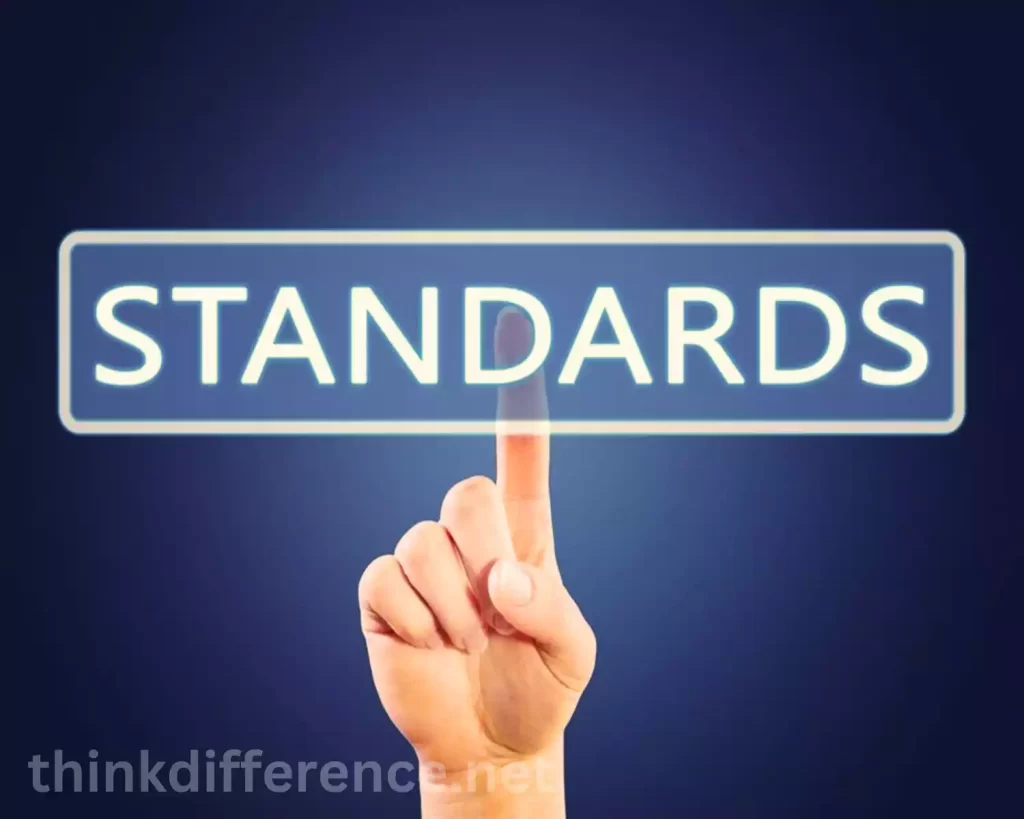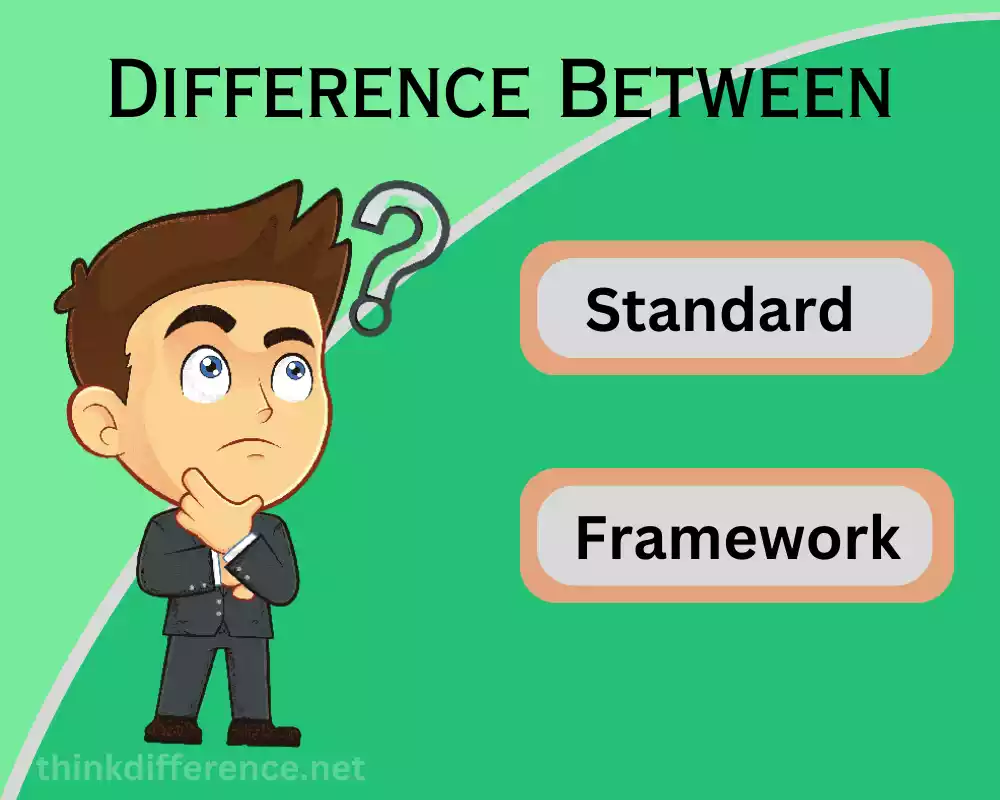Definition of Standard and Framework
Standard: Standard is a set of specifications or criteria which serve as benchmarks or references for quality, safety, interoperability or any other quantifiable attributes that define quality in products, services or processes. Standardization has become widely accepted within an industry or domain and serves to promote consistency, compatibility and best practices within it. Standards typically developed and maintained through recognized regulatory or non-profit bodies in order to create uniformity across their offerings.
Framework: Frameworks are organized, reusable software or conceptual architectures used as the basis for developing applications, systems or solutions. Frameworks contain predefined rules and functionality which developers can leverage to simplify development efforts. Frameworks contain pre-designed libraries, modules, tools and other components which enable them to quickly solve problems, follow coding conventions or manage common tasks efficiently.
Frameworks provide a reusable architecture or structure that can be used to construct applications and systems quickly, while frameworks come pre-packaged with structures and functionality for development purposes. Standards aim at setting common guidelines.
Understanding the differences between Standard Framework and Standards is vitally important
Understand the differences between standards and frameworks is of immense value in many situations.
- Appropriate Selection: Understanding the differences allows organizations or individuals to select the ideal approach for them. Understanding standards vs frameworks provides crucial context when making informed decisions.
- Problem Solving: Frameworks And Standards frameworks offer structured approaches to problem-solving while standards focus on outlining guidelines. Being aware of these differences allows individuals to determine whether a standard or framework may best address a given challenge.
- Development Efficiency: Frameworks offer predefined libraries and tools designed to speed the development process and can save developers both time and energy when it comes to understanding workflow. Standards ensure interoperability which is especially crucial in collaborative development efforts.
- Compatibility and Integration: Standards are integral for ensuring seamless integration and compatibility among systems, products, or services. By understanding their importance and following guidelines outlined by standards to achieve smooth interoperability between them all – individuals or organizations alike can follow them more easily than previously. While frameworks do not focus exclusively on interoperability they may integrate existing standards or offer their own conventions to facilitate integration more smoothly.
- Industry Compliance: Numerous industries must conform to specific standards and regulatory requirements, so being aware of frameworks versus standards allows compliance with industry specific guidelines ensuring legality as well as operational compliancy.
- Knowledge Sharing: Standards facilitate knowledge-sharing by creating a common language and set of guidelines, which allows organizations and individuals to effectively collaborate within their industry, exchange information effectively between departments or sectors and share resources among themselves. Frameworks also contribute towards knowledge-sharing through creating architectural patterns or methods used consistently across organizations or industries.
Understanding the differences between standards and frameworks will enable you to make more informed decisions, solve issues more effectively, comply with regulations more quickly, share knowledge more efficiently and gain knowledge faster. Individuals and organizations alike can select the most beneficial approach for their situation from both frameworks and standards available today.
What is Standards?
Standards are guidelines, specifications or criteria which establish performance levels, quality characteristics, safety measures or other measurable features for products, processes, systems or services in an industry, sector or domain. Standards serve as benchmarks or references that promote uniformity and consistency within an industry sector or domain.

Standardization provides organizations and individuals with a framework to meet predetermined criteria and realize desired results. Standards can be utilized across numerous fields such as manufacturing, technology and healthcare delivery systems, transportation networks, telecom services providers and environmental protection.
Collaboration among experts, stakeholders, regulatory agencies and industry associations is necessary in creating standards. They are informed by research findings, industry knowledge and consensus. All standards undergo a stringent validation and updating process to ensure they remain effective and relevant over time.
Compliance with standards may be mandatory or voluntary, depending on your circumstances. Certain laws, regulations and contractual agreements may mandate adherence to specific standards; compliance is the process of assuring products, services or processes meet specific criteria while aligning with industry best practices.
Standards play a crucial role in various aspects, including:
- Quality Assurance: Standards allow organizations to improve and sustain the quality of products offered, leading to increased customer satisfaction and building trust with clients.
- Interoperability: Standardization provides protocols, formats or interfaces that facilitate interoperability between disparate products or services by creating protocols or formats which establish protocols, formats or interfaces to allow systems or products to effectively collaborate on projects that differ in terms of technology and services; they help ensure seamless integration and compatibility among different components.
- Safety and Security Standards: These standards offer guidelines and requirements for ensuring safety and security across a range of domains, helping mitigate risks, safeguard public health, and address potential hazards.
- Standards and Innovation: Standards promote innovation by serving as a point of reference and common platform for research, development, collaboration and advancement of industries. In turn, they facilitate knowledge transfer between professionals as well as encouraging continuous improvement over time.
- Market Access and Competitiveness: Adherence to relevant standards can open up new opportunities, increase competitiveness, and allow organizations to reach out to new customers or markets. Compliance with such standards may even be mandatory before entering an industry’s regulated environment.
Organizations and professionals must abide by relevant standards to ensure compliance, promote interoperability, maintain quality, stay current with best practices in their fields and stay compliant. Standards provide consistency, safety, efficiency and continuous improvement across industries and domains.
What is Frameworks?
Frameworks are pre-designed software architectures and structures that have been pre-created, providing rules, conventions, functionality and tools to make software development simpler and faster. Frameworks offer the tools needed for building software apps or solutions more quickly.

Frameworks offer developers an organized way of building software. This enables them to focus their attention on implementing business logic rather than having to start from scratch, with reusable components and libraries that help solve common problems and tasks more quickly while saving both time and effort. Frameworks incorporate well-established design patterns, conventions and best practices which aid code organization, maintainability and scalability.
Frameworks play a crucial role in various aspects, including:
- Efficiency and Productivity: Frameworks offer a structured approach with pre-built components, which eliminates repetitive coding tasks. Frameworks also serve as an indispensable source of ready-made tools that facilitate development processes more quickly, increasing productivity while decreasing time to market.
- Code Organization and Maintainability: Frameworks provide code organization and maintainability by following architectural patterns and coding standards. Frameworks also offer guidelines for structuring code to make enhancement, debugging and maintenance of applications simpler – thus improving maintainability as the likelihood of errors or inconsistencies decrease.
- Scalability and Flexibility: Frameworks provide developers with flexibility, offering features that facilitate scalability. Furthermore, frameworks usually include architectural patterns and features to facilitate application growth and development as well as mechanisms to handle increased user traffic, manage large datasets and integrate with other systems. Frameworks offer developers flexibility by allowing them to modify or extend components according to business requirements.
- Consistency and Best Practices: Frameworks use best practices to standardize approaches to development. They offer guidelines on error handling, data validation and security implementations – helping developers ensure consistent projects while decreasing performance or security risks.
- Security and Reliability: Frameworks are typically equipped with security features to safeguard applications against potential vulnerabilities. Such safeguards could include data validation, input sanitization and authentication features built directly into them. Frameworks also typically undergo rigorous testing processes which strengthen them against potential threats and vulnerabilities.
- Community and Support: Many frameworks are supported by active communities of developers who contribute to its enhancement while offering tutorials, documentation and support for it. Community resources make it easier for developers who are experiencing difficulties to troubleshoot issues themselves quickly or need additional guidance or need help from fellow programmers.
- Integration and Interoperability: Frameworks facilitate seamless integration with other technologies, APIs or databases to make interfacing easier between various components or services. They offer standard protocols and interfaces which promote interoperability among various services or components.
- Standards and Compliance in Industry: Frameworks can incorporate standards and compliance requirements that ensure applications comply with specific guidelines or regulations, such as data privacy, accessibility or regulatory needs. By offering mechanisms for their implementation, frameworks reduce development effort.
- Learning and Skill Development: Frameworks are educational tools designed to assist developers in honing their skills and learning the industry’s best practices. Frameworks teach architectural patterns and coding techniques as well as expose developers to widely accepted practices – these skills can then be put to use on future projects or career opportunities.
Frameworks are essential tools for increasing software development efficiency, maintainability and security. Frameworks offer developers an indispensable source of support in building robust and dependable apps.
Comparison Chart
This comprehensive chart highlights the main differences between frameworks and standards:
| Aspect | Standards | Frameworks |
|---|---|---|
| Purpose | Establish guidelines and specifications | Provide a pre-designed structure and tools |
| Focus | Quality, interoperability, best practices | Development process, efficiency, code organization |
| Scope | Industry-wide or domain-specific | Technology, programming language, application-specific |
| Nature of Guidance | Guidelines, specifications, requirements | Pre-defined structure, rules, conventions |
| Flexibility | Generally less flexible, defined by the standard | Customizable and adaptable to specific needs |
| Compliance | Ensures uniformity, compatibility, and best practices | Not directly related to compliance, but may follow standards |
| Level of Abstraction | High-level guidelines or principles | Concrete implementation details, code libraries |
| Interoperability | Focuses on ensuring compatibility between systems | May integrate with standards or provide own conventions |
| Custom Development | Not intended for custom development or specific use cases | Supports custom development and addressing specific needs |
| Learning Curve | Requires understanding and adherence to guidelines | Learning the framework’s architecture and best practices |
| Community Support | Collaboration among industry stakeholders | Active community for sharing knowledge and support |
When to Use Standards or Frameworks
Use Standards When:
- Ensuring Compliance: Standards can provide organizations with a set of clear guidelines and specifications they can follow to meet legal or regulatory obligations and ensure compliance.
- Promoting Interoperability: Standardization is a key factor for ensuring interoperability and compatibility when creating products and systems that interact. Adopting industry standards or technical specifications enables seamless integration among the various components or services.
- Establishing Best Practices: Standardization is key for achieving quality, safety, or other outcomes. They provide guidelines, protocols, and procedures designed to promote industry best practices while creating uniformity across organizations or projects.
- Standards increase quality and safety: Standards set benchmarks for performance, safety, and reliability in products, processes, services, or environments compared against predefined standards, which helps provide improved quality control and risk-management practices.
- Facilitating Collaboration: Standards provide a universal language between stakeholders, industry experts and organizations, and foster knowledge sharing, communication and cooperation between all sectors or domains of an industry or domain.

Figure 03: When to Use Standards or Frameworks
Use Frameworks When:
- Streamlining Development: Development Frameworks can be invaluable if you want to reduce coding and speed up development. They offer pre-designed frameworks, components and libraries designed specifically to build applications faster.
- Improving Productivity: Frameworks help developers boost productivity by equipping them with tools, utilities, and predefined functionality that allows them to focus more on business logic instead of dealing with low level details or reinventing solutions.
- Enhancing Code Organization: Frameworks offer architectural patterns, coding standards and guidelines designed to promote modularity and maintainability within code bases. Frameworks offer a structured method that promotes clean code that makes maintaining applications and improving them easier over time.
- Scaling Applications: When scaling is an issue, frameworks offer features and patterns that support growth. They offer mechanisms to handle increased user traffic, manage large datasets efficiently and distribute workloads efficiently.
- Employing Community and Ecosystem: Frameworks with active communities gives developers access to an abundance of knowledge, resources, and support. Forums, documentations, tutorials and plugins all provide invaluable assistance as well as insights from others’ experiences that they may find invaluable.
- Customizing to Specific Needs: Frameworks can be tailored and modified to fit specific project needs. Frameworks offer hooks, extensions, and APIs that enable developers to adapt the framework according to their specific project demands.
- Accelerating Learning and Skill Development: Frameworks are educational tools designed to assist developers in mastering industry best practices, architectural patterns, and coding methods. Frameworks enable programmers to familiarize themselves with widely accepted practices while improving their skillset and shortening the learning curve.
Decisions on frameworks vs standards will depend on the goals, constraints, and requirements of your project or organization. They may even work in concert; frameworks adhering or implementing relevant standards to achieve desired results.
Conclusion
Standards and Frameworks are invaluable tools that guide organizations toward success by promoting quality, efficiency, and best practices. By adhering to relevant standards and adopting appropriate frameworks, businesses can gain a competitive advantage and achieve their goals effectively.



